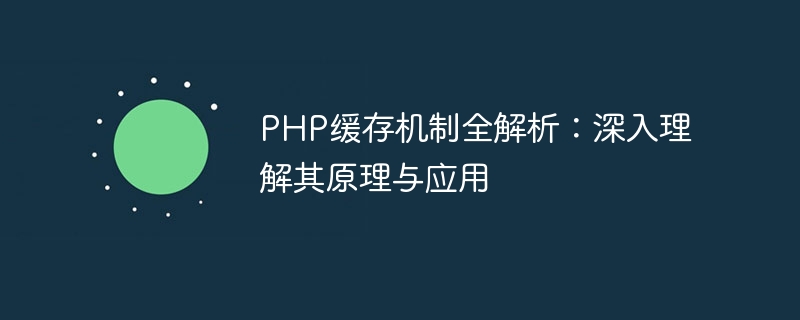
Full analysis of PHP caching mechanism: in-depth understanding of its principles and applications
Introduction:
In the development of Web applications, caching is an important technical means , can significantly improve application performance and user experience. As a commonly used server-side programming language, PHP also provides a rich caching mechanism for developers to use. This article will delve into the principles and applications of PHP caching mechanism and give specific code examples.
1. The principle of caching
Before introducing the PHP caching mechanism, we need to understand the basic principles of caching. Caching is a technology that saves data in high-speed storage media for quick access. When an application needs to access certain data, it will first try to obtain it from the cache. If the data does not exist in the cache, it will obtain it from the source data storage medium and put it in the cache for the next access. .
2. Classification of PHP caching mechanism
In PHP, the caching mechanism can be divided into two types: client-side caching and server-side caching.
- Client-side caching
Client-side caching refers to caching technology that saves data in the client browser. When the browser needs to access the same resource, it can obtain the data directly from the client cache, thereby improving access speed. Common client-side caching technologies include HTTP caching and browser caching.
- HTTP cache: Control the browser's caching behavior of resources by setting the Cache-Control and Expires fields in the HTTP response header. For example, we can set the max-age attribute of the Cache-Control field to specify the cache validity period.
- Browser cache: The browser will cache some static resources (such as CSS, JavaScript, pictures, etc.) into the local file system, and obtain them directly from the local cache the next time you visit, saving network bandwidth and servers resource.
- Server-side caching
Server-side caching refers to caching technology that stores data in server memory. When the server needs to access the same resource, it can fetch the data directly from the cache without having to fetch it from the database or other external storage again. Common server-side caching technologies include page caching, database query caching, and object caching.
- Page caching: Save dynamically generated page content in the cache, and directly return the cached static page the next time the same page is requested, avoiding repeated calculations and database queries.
- Database query cache: Save the results of database queries in memory, and directly return the cached results the next time you query the same data, reducing the pressure on the database.
- Object cache: Save frequently used objects in the cache and obtain them directly from the cache the next time they are used, which improves the response speed of the program.
3. Implementation of PHP caching mechanism
In PHP, we can use a variety of methods to implement the caching mechanism. The following will introduce the implementation methods of page caching, database query caching and object caching respectively.
- Page Cache
PHP provides functions such as ob_start() and ob_end_flush(), which can save the page content to the cache and output it. By calling the ob_start() function at the beginning of the page, the page is cached, and then the ob_end_flush() function is called at the end of the page to output the cached page content.
<?php
ob_start();
// 生成页面内容
$output = ob_get_clean();
echo $output;
?>
- Database query cache
In the MySQL database, you can cache query results by setting the query cache. We can use the SQL_CACHE keyword in the SQL statement or set cache parameters to control the caching of query results.
SELECT SQL_CACHE * FROM users WHERE id = 1;
- Object caching
In PHP, we can use third-party libraries such as memcached extension or Redis extension to implement object caching. These extensions provide a series of functions to operate cached data, such as memcached_get(), memcached_set(), etc.
<?php
$mem = new Memcached();
$mem->addServer('localhost', 11211);
// 从缓存中获取数据
$data = $mem->get('user_1');
// 如果缓存中不存在,则从数据库中取出并保存到缓存中
if (!$data) {
$data = // 从数据库中获取数据
$mem->set('user_1', $data, 60); // 保存到缓存中,有效期为60秒
}
// 使用$data数据
?>4. Application Scenarios and Precautions
- Application Scenarios
The caching mechanism can be applied to various Web applications. For frequent database reading and calculation It is particularly effective in scenarios such as complex pages and large access to static resources.
- Notes
- The cache granularity should be moderate. If it is too small, the cache hit rate will be low, and if it is too large, the cache will be too large.
- The cache validity period must be well controlled. If it is too long, the cached data will expire. If it is too short, the cache will expire frequently.
- When updating data, the cache must be updated in time to ensure cache consistency.
Conclusion:
Through this article's analysis of the principles and applications of the PHP caching mechanism, we understand that caching is an important means to improve application performance. By properly using the caching mechanism, we can effectively reduce server load and improve user access experience. At the same time, in the process of using cache, we also need to choose an appropriate cache strategy based on specific scenarios, and pay attention to settings such as cache granularity and validity period.
Reference:
- The PHP Manual: https://www.php.net/manual
- Memcached: https://memcached.org/
- Redis: https://redis.io/
The above is the entire content of this article. I hope it will be helpful to you in understanding the PHP caching mechanism.
The above is the detailed content of Detailed explanation of PHP caching mechanism: in-depth exploration of its working principle and practical application. For more information, please follow other related articles on the PHP Chinese website!
